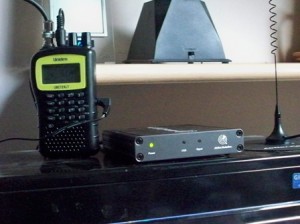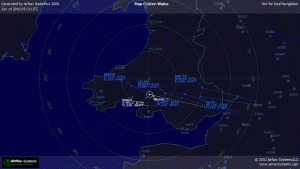One of the advantages of living in Swansea is that we lie beneath one of the main flight paths crossing the Atlantic. Aircraft going to and from North America use pre-designated routes across the Atlantic similar to roads known as North Atlantic Tracts (NAT’s). On a clear day, especially first thing in the morning the sky above my house is a network of vapour trails from all the air-traffic overhead. I bought a scanner last year with the intention of doing a bit of Airband listening and plane spotting and find out what was goig on up above.
A scanner takes a bit of getting used to if you’re used to a traditional HF or SW receiver like me. Having switched the thing on and hearing bugger all I consigned it to the top shelf of the shack, where it lay until a few weeks ago. I eventually decided to do a bit of research, find out what frequencies to listen to and how to use the machine and hey-presto I haven’t looked back since. I now have constant airband traffic as the pilots communicate with ATC in Shanwick requesting flight clearances to descend into Heathrow or Oceanic Clearance for flights over the North Atlantic.
To really go the extra dimension in airband listening I decided to knock-up a virtual radar system in order to help identify the air traffic. Traditionally, ATC’s use primary surveillance radar for monitoring aircraft. More recently, modern aircraft now carry Automatic Dependent Surveillance Broadcast (ADS-B) and Mode-S radar transponders that broadcast on 1090 MHz. Mode-S involves a unique ICAO 24-bit address asigned to an aircraft that can be selectively interrogated to provide information on it’s identity, flight heading, altitude and speed. The ADS-B is linked into the GPS system and therefore we can plot it’s position on a screen.
There are two main systems that are available on the market for receiving ADSB/Mode-S transmissions and linking them to a PC via virtual radar software. The AirNav Radarbox is probably the most popular followed by the SBS Kinetic system. I’m using the Air Nav system and so far it has been excellent. Not only can I listen to the air traffic above me but can see exactly what plane it is, where it’s going , speed , direction and height all on a radar image on my computer. Furthermore the software also links to the internet providing a photo of the actual aircraft and networks with other users to provide almost worldwide coverage.The set up is shown below, scanner on the left and the radarbox next to it.
The picture below is a snap shot of whats going over the house first thing in the morning.
The system comes with a small mobile antenna that is pretty good, however, I have made a homebrew 1090 MHz vertical basestation antenna that performs sightly better allowing me to receive planes that are about 100 miles away, not bad considering we live at the bottom of a valley.Below you can see the scanner antenna alongside the 1090Mhz vertical (right). This was quite a simple job being made from plastic pipe and an aluminium ground plane base plate. The vertical element consists of a copper wire with 2 single turn loading coils spaced 15 cm apart.


